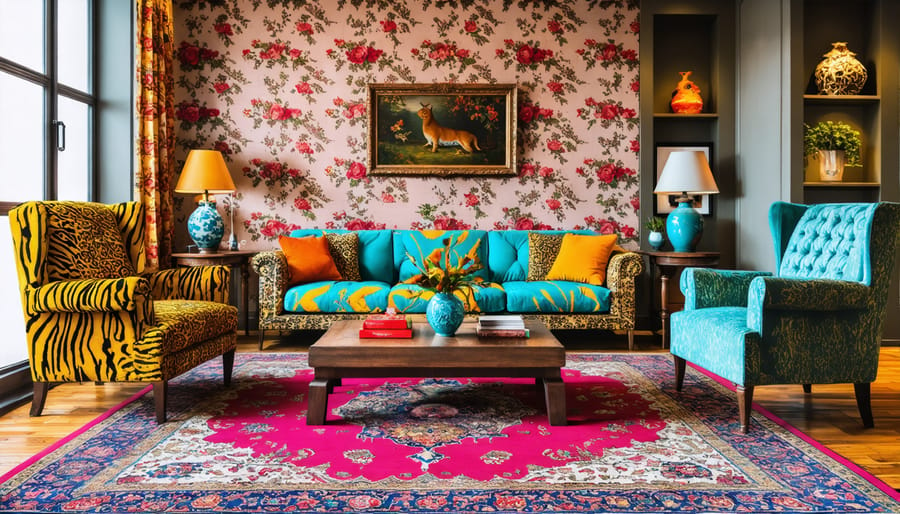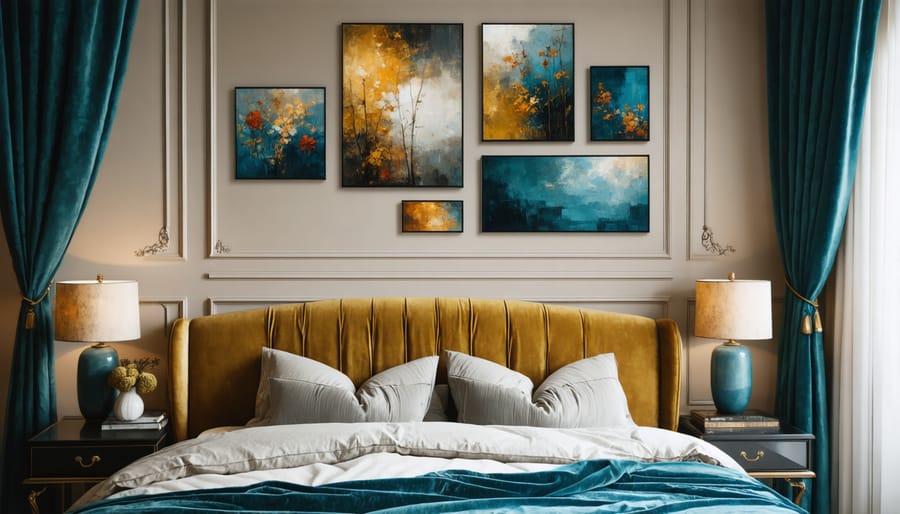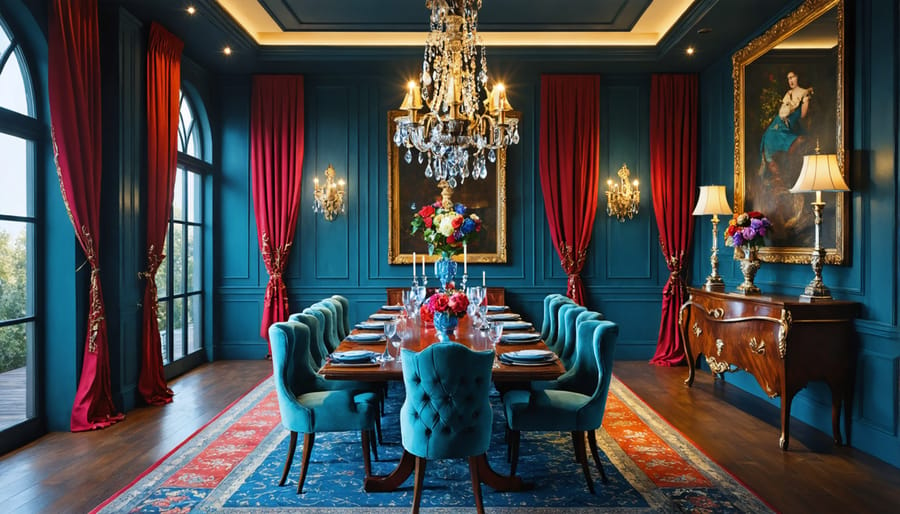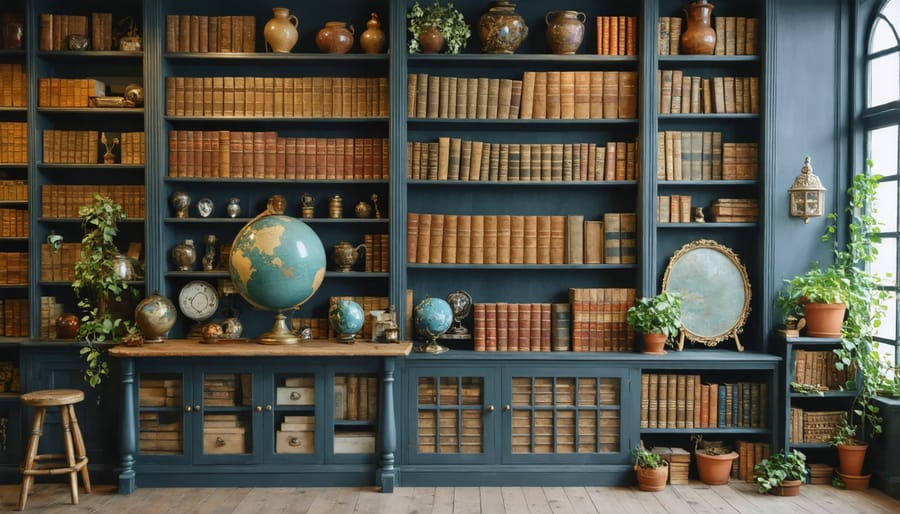Embrace the boldness of maximalist design by layering rich, contrasting patterns across different textiles – from throw pillows to wallpaper and upholstery. Mix three or more distinct yet complementary colors throughout your space, anchoring them with a dominant hue that appears in at least 60% of your decor elements. Transform blank walls into gallery-style focal points by clustering vintage artwork, ornate mirrors, and personal photographs in varied frames and sizes. Unlike minimalism’s restrained approach, maximalism thrives on thoughtfully breaking traditional interior design theories to create spaces that tell your unique story through carefully curated collections, bold architectural details, and unexpected combinations of textures and materials.
Fill empty corners with statement furniture pieces that double as conversation starters – think jewel-toned velvet armchairs or gold-leafed accent tables paired with dramatic floor lamps. Layer lighting at different heights using chandeliers, sconces, and table lamps to create depth and drama while highlighting your carefully chosen decorative elements. Remember: successful maximalist spaces balance visual excitement with purposeful arrangement, ensuring each piece contributes to your room’s overall narrative without crossing into chaos.
The Art of More is More: Core Principles of Maximalist Design
Pattern Play and Color Mixing
Mixing patterns and colors is where maximalist design truly shines, but it requires a thoughtful approach to avoid chaos. Start by understanding basic color wheel principles to create harmonious combinations that pack a punch. Choose a dominant color as your foundation, then layer in 2-3 complementary or analogous hues for balance.
When it comes to patterns, follow the rule of scale: mix large, medium, and small prints to create visual interest without overwhelming the space. For example, pair a large floral wallpaper with medium-sized geometric cushions and small-scale striped accessories. Maintain cohesion by repeating colors across different patterns or selecting prints within the same color family.
Don’t shy away from bold combinations – try animal prints with florals, or geometrics with ethnic patterns. The key is to include a unifying element, whether it’s a consistent color thread or similar pattern style. Break up intense pattern combinations with solid-colored pieces to give the eye a place to rest.
For beginners, start with a 60-30-10 ratio: 60% dominant pattern/color, 30% secondary pattern/color, and 10% accent pattern/color. As you grow more confident, experiment with different proportions and unexpected combinations. Remember, maximalism celebrates personal expression, so trust your instincts while maintaining these foundational principles.

Layering and Texture Composition
The magic of maximalist design lies in masterful layering, where each element builds upon another to create a rich, multidimensional space. Start with your foundation layer – typically larger pieces like rugs, furniture, or wallpaper – and gradually build upward. Mix textures liberally: combine plush velvet cushions with rough-woven throws, sleek ceramic vases with natural wicker baskets, and smooth metallic accents with chunky knit textiles.
Don’t shy away from combining patterns at different scales. Layer a large floral print with smaller geometric designs, or mix striped pillows with animal print throws. The key is to maintain a visual connection through color or pattern repetition. Remember to create depth by varying heights and dimensions – arrange items at low, medium, and high levels throughout the room.
Experiment with unexpected combinations like placing ornate vintage frames against textured grasscloth wallpaper or layering multiple area rugs with contrasting patterns. Add dimensional elements such as tapestries, wall hangings, or sculptural pieces to create visual interest that draws the eye up and around the space.
For maximum impact, incorporate different material finishes. Blend matte and glossy surfaces, smooth and textured fabrics, and natural and manufactured materials. This creates a dynamic interplay of light and shadow that brings your maximalist space to life. Remember to step back occasionally to ensure your layers work together harmoniously rather than competing for attention.
Room-by-Room Maximalist Magic
Living Room Statement Pieces
The living room is your perfect canvas for embracing the “more is more” philosophy of maximalism. Start with an attention-commanding piece like an oversized vintage mirror with an ornate gold frame or a bold, jewel-toned velvet sofa that beckons everyone to sit. These statement pieces set the stage for your maximalist vision while providing a focal point that anchors the space.
Layer your lighting to create drama and depth. Combine a striking chandelier with unique table lamps and strategic accent lighting. Mix metals and finishes – think brass sconces alongside chrome floor lamps – to add visual interest and complexity to your lighting scheme.
Don’t shy away from gallery walls that tell your story. Mix framed artwork, mirrors, and wall sculptures in varying sizes and styles. The key is to maintain a sense of cohesion through color palette or theme while embracing eclectic combinations.
Consider unconventional furniture choices like a leopard-print armchair or a baroque-style coffee table with intricate detailing. These pieces become conversation starters and inject personality into your space. Add dimension with textiles – layer richly patterned throw pillows, drape luxurious throws, and incorporate plush area rugs with bold designs.
Plants can serve as living statement pieces too. Group large-leafed specimens like monstera or fiddle leaf figs with smaller varieties to create a lush indoor jungle effect. Display them in decorative containers that complement your overall design scheme.
Remember, the goal is to create a space that feels curated rather than cluttered. Each statement piece should have room to breathe while contributing to your room’s overall narrative. Don’t be afraid to edit and rearrange until you achieve the perfect balance of drama and livability.
Bedroom Abundance
Transform your bedroom into a captivating sanctuary by embracing the “more is more” philosophy of maximalist design. Start with a foundation of rich, layered textiles – think velvet throw pillows in jewel tones, embroidered quilts, and tapestry-style wall hangings that create a cozy atmosphere while adding visual interest.
Don’t shy away from mixing patterns and textures. Layer a Persian-style rug over wall-to-wall carpeting, or combine several smaller rugs for an eclectic look. Your bed can become a stunning focal point with multiple pillows in varying sizes, patterns, and fabrics, topped with a dramatic headboard in bold upholstery or intricate carved wood.
Personal collections take center stage in maximalist bedrooms. Display vintage jewelry on decorative stands, arrange beloved books in rainbow order on floating shelves, or create a gallery wall mixing framed artwork with personal photographs and treasured mementos. Consider installing picture rails to rotate displays seasonally without damaging walls.
Add depth with different lighting sources: a statement chandelier, vintage table lamps, and wall sconces can create ambient layers while showcasing your personality. Incorporate plants of varying heights and textures to bring life to corners and windowsills.
For storage, choose pieces that double as display opportunities – an antique armoire with glass doors, ornate dressing tables, or vintage trunks that serve as both storage and seating. Remember, in maximalist design, even practical items should contribute to the room’s overall aesthetic appeal.

Dining Room Drama
Transform your dining room into a feast for the eyes with maximalist design choices that make every meal an event to remember. In maximalist style, your dining space should tell a story and spark conversation, making it the perfect setting for memorable gatherings.
Start with a statement wallpaper featuring bold botanical prints or dramatic geometric patterns. Don’t shy away from rich, deep colors like emerald green, royal blue, or burgundy for your walls – these create an intimate atmosphere perfect for dining. Layer this foundation with oversized artwork or a gallery wall mixing various styles and frames.
Your dining table becomes a canvas for creative expression. Mix and match dining chairs in complementary styles and upholster them in different fabrics that share a color story. Add drama with an eye-catching chandelier or pendant light – strategic lighting design can transform the entire mood of your space.
Don’t forget the power of textiles and accessories. Layer table runners with bold patterns, use mismatched vintage plates, and incorporate ornate candlesticks of varying heights. A large mirror with an elaborate frame can amplify the space while reflecting your carefully curated design elements.
For additional visual interest, consider adding a statement sideboard decorated with a collection of vintage vessels, art pieces, or family heirlooms. Plants and fresh flowers in decorative containers add life and organic shapes to the mix.
Remember, in maximalist design, more is more – but thoughtfully so. Create visual harmony by repeating colors throughout your accessories and ensuring there’s a deliberate flow to your choices. The key is to make the space feel curated rather than cluttered, allowing each element to contribute to your dining room’s unique story.

Practical Tips for Maximalist Success
Creating Visual Balance
Creating visual balance in a maximalist space might seem challenging, but it’s actually one of the most crucial elements for making this bold design style work. Think of your room as a carefully composed painting – while it may be full of colors and patterns, it needs structure to feel intentional rather than chaotic.
Start by establishing anchor points in your space. Large furniture pieces, like sofas or beds, can serve as visual foundations around which you can build your design. These pieces don’t need to be neutral, but they should provide a solid base for your more eclectic elements.
Color coordination is your secret weapon. Choose a primary color palette of 3-4 colors that will appear consistently throughout your space. Then, add 2-3 accent colors that pop up in smaller doses. This creates a thread of continuity even when mixing different patterns and textures. For example, if you’re working with deep blues and emerald greens, consider adding touches of gold or coral as accents.
The rule of repetition helps create harmony in busy spaces. Repeat certain colors, patterns, or shapes at different points throughout the room. This might mean using the same animal print on both a throw pillow and a lamp shade, or echoing a particular shade of purple in both artwork and vases.
Consider the visual weight of your items and their distribution in the space. If you have a heavy, ornate mirror on one wall, balance it with a gallery wall or a large piece of furniture on the opposite side. Height variation is also important – mix tall elements with medium and low-height pieces to create an engaging visual journey through the space.
Remember to incorporate negative space strategically. While maximalism embraces fullness, small pockets of emptiness help the eye rest and make the overall composition more impactful. Think of these as brief pauses in a symphony rather than complete silence.
To maintain balance while layering, work in triangles. Place similar elements in a triangular pattern around the room to create a sense of movement and prevent any one area from feeling too heavy or sparse.
Curating Your Collections
In maximalist design, your collections tell your story, and displaying them effectively is an art form in itself. The key is to create intentional arrangements that celebrate your treasures without crossing into chaos. Start by grouping similar items together – whether it’s vintage cameras, colorful pottery, or cherished travel souvenirs. This creates visual cohesion and makes even eclectic collections appear purposeful.
Consider creating “zones” throughout your space, using stylish storage solutions like floating shelves, vintage cabinets, or glass display cases. Layer your items at varying heights and depths to create visual interest – place taller items at the back, medium-sized pieces in the middle, and smaller treasures in the foreground.
Color coordination can help unite diverse collections. Try arranging books by color to create a rainbow effect, or group items by material or finish. Don’t be afraid to mix and match different styles – vintage photographs can live harmoniously alongside modern art pieces when thoughtfully arranged.
Remember the rule of odd numbers – grouping items in threes, fives, or sevens tends to be more visually appealing than even numbers. Create mini focal points throughout your space, ensuring each collection has room to breathe. Use trays, pedestals, or decorative boxes to elevate certain pieces and create distinct vignettes.
Rotate your displays seasonally to keep your space feeling fresh and prevent dust accumulation. This also gives you the opportunity to showcase different pieces from your collection throughout the year. When arranging multiple collections in one room, maintain visual balance by varying the scale and density of your displays.
Most importantly, ensure each item on display holds genuine meaning or brings you joy. In maximalist design, every piece should contribute to your personal narrative, creating a space that’s not just visually striking but deeply personal and engaging.

Common Maximalist Mistakes to Avoid
While maximalism encourages creative freedom, there are several common mistakes that can make your space feel chaotic rather than curated. The key is knowing where to draw the line between bold expression and visual overwhelm.
One frequent pitfall is mixing too many competing patterns without a unifying element. To avoid this, choose patterns that share at least one color or maintain a similar scale. When combining prints, follow the 60-30-10 rule: use your dominant pattern for 60% of the space, a secondary pattern for 30%, and an accent pattern for 10%.
Another mistake is neglecting negative space entirely. Even maximalist rooms need breathing room. Create small pockets of visual rest between your statement pieces to help the eye navigate the space. Think of it as framing your treasured items rather than cramming them together.
Many newcomers to maximalism fall into the trap of random collecting without a cohesive vision. While eclectic is good, your items should tell a story or share some connecting thread. Before adding new pieces, consider how they relate to your existing collection in terms of color, era, or theme.
Overlooking lighting is another common error. Proper illumination is crucial in maximalist spaces to highlight your collections and create depth. Layer your lighting with a mix of overhead, task, and accent lights to properly showcase your carefully curated displays.
Lastly, avoid sacrificing functionality for aesthetics. Your space should still be livable and comfortable. Ensure pathways remain clear and seating areas aren’t overwhelmed by decorative items. Remember, maximalism is about creating joy, not obstacles.
Embracing maximalist interior design is more than just following a trend – it’s about creating a space that truly reflects your personality and tells your unique story. Throughout this guide, we’ve explored how to blend bold colors, mix patterns, layer textures, and curate meaningful collections to create spaces that are both visually striking and deeply personal.
Remember, there’s no single “right way” to do maximalism. The key is to trust your instincts while keeping basic design principles in mind. Start with pieces you love, experiment with different combinations, and don’t be afraid to adjust as you go. Whether you’re drawn to vibrant tropical prints, vintage finds, or eclectic art collections, your maximalist journey should feel authentic to you.
Begin small if you’re feeling uncertain – perhaps with a feature wall or a carefully styled bookshelf – and gradually build your confidence. Pay attention to how different elements make you feel in the space. The best maximalist rooms aren’t just visually impressive; they’re comfortable, functional, and bring joy to those who live in them.
As you move forward with your maximalist design plans, remember that this style is fundamentally about expression and creativity. Break free from minimalist constraints, embrace the pieces that speak to you, and create a home that celebrates abundance, personality, and the art of living boldly. Your perfect maximalist space awaits!
